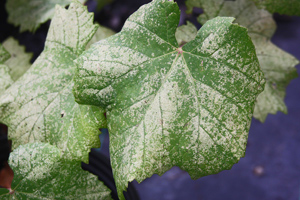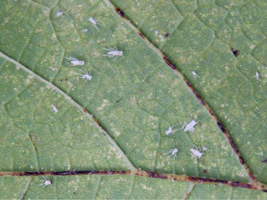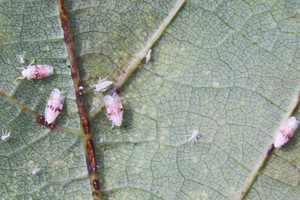|
Leafhoppers and Lacebugs – Two More Leaf – Sucking Insects
Insects that use special sucking mouth parts to feed on sap and plant cells include some of the most diverse and interesting insects in the garden. They can also be some of the most destructive pests in home landscapes. Unlike the beetles and ants with their chewing mouth parts, insects that feed on sap have piercing/sucking mouth parts. Damage from sap feeders can be difficult to spot at first. After a while, however, plants being attacked by sap-feeders will take on a shiny look and sticky feel. Eventually these sticky plants may turn black with a coating of black sooty mold, a type of fungus that grows on the sugars in the drippy droppings of sap-feeders. Common sap-feeding insects include mealybugs, scale insects, aphids, true bugs and whiteflies.
Not all plant-feeding insects with sucking mouth parts feed on sap. Some feed on the inner tissues of leaves, called mesophyll (MEEZ oh fill). Mesophyll includes the food producing (photosynthetic) cells layers of a leaf that lie between the upper and lower epidermis. Symptoms of mesophyll feeding include a stippled pattern of yellowish, gray or whitish dots on the plant surface. This damage causes the leaf color to dullen, turn yellow or gray, and eventually brown. Other mesophyll feeders may leave pits or sunken areas of leaves that eventually turn brown and die. Spider mites, leafhoppers, lace bugs and yucca bugs are examples of mesophyll-feeders common in Texas landscapes.
We get lots of questions about lace bug damage, especially on lantanas.
Calvin Finch writes:
Lantanas are perennials. They come in many colors and sizes. All do best in full sun where they are generally deer proof, drought tolerant and pest resistant. The exception to the pest-free claim has been damage by lace bugs on many plantings. The lace bugs suck the juices from the leaves to reduce blooming for a while and leave the foliage looking faded and dusty. The little beetles suck the juices from the plants just like spider mites, scale or aphids. The symptom is the same as well; the foliage becomes dusty or milky looking. The plants recover, but a spray at first sign of a symptom on the foliage or if the plant stops blooming will eliminate the problem. The blooms are usually cyclical, in that they bloom for six weeks, rest for six weeks, and then bloom again. Area landscapers have speeded up reblooming by deadheading the planting every three or four weeks. A light (one-half inch deep) pruning with the string mower stimulates the new flush of flowers.
Question.
The lantana was blooming strong but now the bloom has quit and the leaves have a dusty, dirty look.
Answer.
Sucking insects have attacked the plant. In the case of lantana it is probably lace bugs. Trim the damaged foliage and spray with Orthene systemic insecticide (acephate) or Spinosad. Organic gardeners can also try Neem oil to control lace bugs.

Leafhopper damage on grape |

Leafhopper nymphs on bottom of grape leaf
|

Leafhopper on grape leaf |
|
|
|
|



